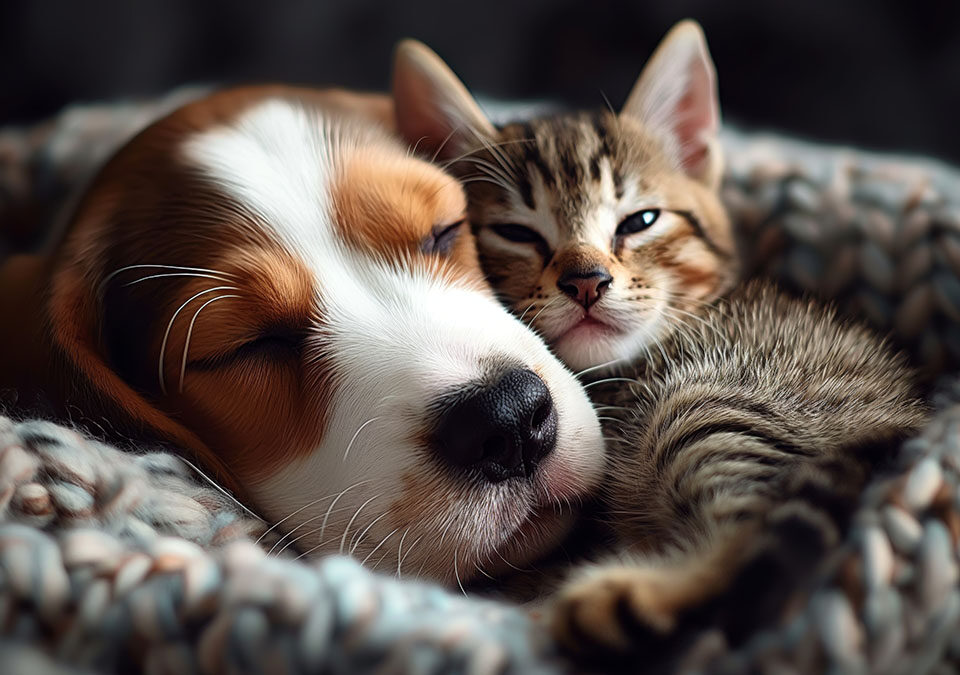
Get Peace of Mind for Your Furry Friend: Unveiling the Importance of Pet Insurance
August 15, 2024
The Top 10 Hypoallergenic Small Dog Breeds You’ll Love
September 12, 2024Leaving your pet behind can be stressful for both of you. As pet owners, it’s essential to understand and address separation anxiety in your furry friends to ensure a stress-free goodbye each time you leave. In this article, we will delve into pet separation anxiety and provide valuable tips to help alleviate your pet’s distress.
Separation anxiety is a common behavioral problem that pets experience when they are left alone or separated from their owners. It can result in destructive behavior, excessive barking, and even physical health issues. While some pets may show immediate signs of distress, others may exhibit more subtle behaviors, making it essential to recognize the signs and take appropriate action.
Fortunately, there are several strategies you can implement to ease your pet’s separation anxiety. From gradual desensitization techniques to engaging toys and calming aids, we will explore various approaches to help your furry friend feel more comfortable when you leave.
Understanding pet separation anxiety and implementing these practical tips can ensure a stress-free goodbye and leave your pet feeling secure and content in your absence.
What is pet separation anxiety?
Pet separation anxiety is a behavioral issue that occurs when a pet, typically a dog or cat, experiences significant distress or anxiety when separated from their primary caregiver or owner. This condition can manifest in various ways, including excessive vocalization, destructive behavior, and even physical symptoms like restlessness, panting, or even self-harm. Separation anxiety is a common problem that can significantly impact the well-being and quality of life of both the pet and the owner.
Understanding the underlying causes and recognizing the signs of separation anxiety is crucial for pet owners to provide their furry companions with the necessary support and care. Separation anxiety is often triggered by a change in routine, a move to a new environment, or the loss of a family member or another pet. Pets with separation anxiety may exhibit heightened attachment to their owners and become distressed when left alone, even for short periods.
Addressing separation anxiety requires a multi-faceted approach that involves gradual desensitization, environmental enrichment, and, in some cases, the guidance of a veterinary behaviorist or certified trainer. By understanding the nature of this condition and implementing effective strategies, pet owners can help their pets overcome the challenges of separation anxiety and foster a more harmonious and stress-free relationship.
Signs and symptoms of pet separation anxiety
Recognizing the signs and symptoms of pet separation anxiety is crucial for pet owners to identify and address the issue effectively. Although the manifestations of separation anxiety can vary from pet to pet, several common behaviors may indicate the presence of this condition.
One of the most evident signs of separation anxiety is excessive vocalization, such as persistent barking, whining, or howling, often occurring shortly after the owner’s departure. Pets may also engage in destructive behaviors, such as chewing, scratching, or attempting to escape from their confinement to reunite with their owner. Some pets may also exhibit signs of physical distress, such as panting, drooling, urinating, or defecating inside the home.
In addition to these overt behaviors, pets with separation anxiety may display more subtle signs, such as increased restlessness, pacing, or an inability to settle down when left alone. Some pets may also exhibit signs of depression or anxiety, such as decreased appetite, lethargy, or a reluctance to engage in their usual activities. By being attuned to these behavioral changes, pet owners can better recognize the signs of separation anxiety and take appropriate steps to address the issue.
Causes of pet separation anxiety
Understanding the underlying causes of pet separation anxiety is crucial for developing effective strategies to manage and prevent this behavioral issue. Several factors can contribute to the development of separation anxiety in pets.
One of the primary causes of separation anxiety is the strong bond and attachment that pets, particularly dogs, form with their owners. When a pet becomes overly dependent on their owner’s presence, the absence of that individual can trigger significant distress and anxiety. This attachment can be exacerbated by changes in the pet’s environment, such as moving to a new home, adding a new family member, or losing a loved one.
Certain genetic and temperamental factors may predispose some pets to developing separation anxiety. Pets with a history of abandonment, neglect, or traumatic experiences may be more prone to this condition, as they may have difficulty coping with the uncertainty of their owner’s absence. Furthermore, certain breeds, such as some herding and working dogs, may be more susceptible to separation anxiety due to their inherent need for companionship and social interaction.
Understanding the impact of separation anxiety on pets
Separation anxiety can have a significant effect on the overall well-being and quality of life of pets, both physically and emotionally. When a pet experiences separation anxiety, the resulting distress can manifest in a variety of ways that can be detrimental to their health and well-being.
Physically, pets with separation anxiety may engage in destructive behaviors, such as chewing, scratching, or attempting to escape their confinement, which can lead to physical harm and injury. The heightened state of arousal and anxiety can also result in physiological symptoms, such as excessive panting, drooling, or even gastrointestinal issues like vomiting or diarrhea. In severe cases, pets may even harm themselves in their attempts to reunite with their owners.
The emotional impact of separation anxiety can be equally profound. Pets with this condition may experience heightened levels of stress, fear, and distress, which can negatively impact their overall mental and emotional well-being. This can lead to a decreased quality of life, as the pet may struggle to find comfort and security in their owner’s absence. The prolonged exposure to this emotional turmoil can also contribute to the development of other behavioral issues, such as increased aggression or phobias.
Tips for preventing or managing pet separation anxiety
Addressing pet separation anxiety requires a multi-faceted approach that combines various strategies to help alleviate the pet’s distress and promote a more positive association with their owner’s absence. Here are some effective tips for preventing or managing separation anxiety in pets:
Creating a routine to ease separation anxiety
Establishing a consistent and predictable routine can be powerful in managing pet separation anxiety. By creating a structured schedule for departures and returns, pet owners can help their furry companions feel more secure and less anxious about their owner’s absence.
One effective strategy is to implement a pre-departure routine, where the owner engages the pet in a calming activity, such as a short walk or playtime, before leaving. This helps to associate the owner’s departure with a positive experience rather than a trigger for anxiety. Additionally, providing the pet with a special treat or toy just before leaving can help distract and comfort them during the separation.
Upon return, avoiding overly enthusiastic greetings is essential, as this can reinforce the pet’s anxiety and make it more difficult for them to settle down. Instead, the owner should greet the pet calmly and avoid direct eye contact or physical contact until the pet can calm down. By creating a consistent routine and managing the owner’s interactions with the pet, pet owners can help their furry companions feel more secure and less anxious during periods of separation.
Providing mental and physical stimulation for your pet
Engaging your pet in regular mental and physical stimulation can be a highly effective way to prevent or manage separation anxiety. Boredom and lack of activity can exacerbate a pet’s anxiety, as they may turn to destructive behaviors to alleviate their distress.
Providing your pet with engaging toys, such as puzzle feeders or interactive treat dispensers, can help keep their minds occupied and reduce the likelihood of anxious behaviors. Additionally, regular exercise, such as daily walks, playtime, or training sessions, can help burn off excess energy and promote a sense of calm and relaxation.
Ensuring that your pet’s physical and mental needs are met can help reduce their overall stress levels and make them less susceptible to separation anxiety. This can also strengthen the bond between you and your pet, as they will associate your presence with positive experiences and a sense of security.
The role of training and positive reinforcement in managing separation anxiety
Incorporating training and positive reinforcement techniques into your pet’s routine can be a highly effective way to address separation anxiety. Through gradual desensitization and counter-conditioning, pet owners can help their furry companions develop a more positive association with their owner’s absence.
One practical approach is to start by exposing the pet to short periods of separation, rewarding them with treats or praise when they remain calm and relaxed. Over time, the duration of the separation can be gradually increased, allowing the pet to become more comfortable with their owner’s absence. This process helps build the pet’s confidence and reduces their anxiety levels.
Additionally, teaching your pet specific commands or behaviors, such as “stay” or “go to your mat,” can give them structure and security during separation. By reinforcing these behaviors with positive rewards, you can help your pet learn to self-soothe and remain calm even when you’re not present.
Seeking professional help for severe cases of separation anxiety
In some cases, pet separation anxiety may be severe or persistent, requiring the guidance of a professional to manage the condition effectively. Veterinary behaviorists and certified animal trainers can provide specialized support and tailored treatment plans to help your pet overcome anxiety.
These experts can assess the underlying causes of your pet’s separation anxiety and develop a comprehensive plan that may include a combination of training, environmental modifications, and, in some cases, medication or supplements. Veterinary behaviorists, in particular, can also rule out any underlying medical conditions that may be contributing to the pet’s anxiety.
Seeking professional help can be particularly beneficial for pet owners who have tried various self-management strategies without success or for those dealing with more complex or severe cases of separation anxiety. With the guidance of a trained professional, pet owners can ensure that their furry companions receive the specialized care and support they need to overcome their separation anxiety and live a happier, more fulfilling life.
Conclusion: Helping your pet overcome separation anxiety
Many pet owners face separation anxiety, a common and challenging issue, but with the right approach and understanding, it can be effectively managed. By recognizing the signs and symptoms of separation anxiety, understanding the underlying causes, and implementing a comprehensive strategy that includes routine, environmental enrichment, training, and professional support, pet owners can help their furry companions overcome this anxiety and enjoy a more stress-free and fulfilling life together.
Remember, every pet is unique, and the approach to managing separation anxiety may need to be tailored to your pet’s needs. Be patient, consistent, and open to trying different strategies until you find what works best for your beloved companion. With time, dedication, and the proper support, you can help your pet overcome the challenges of separation anxiety and foster a strong, healthy, and rewarding bond that will last a lifetime.




